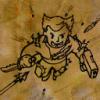I've implemented A* path finding for my units and all my units block nodes within their radii. The nodes are not specifically grid aligned and are positioned in 3D and contain pointers to adjacent nodes. The problem arises when a unit passes another unit and cuts trough. The unit pushes the other unit, which could be a player, out of the way. The problem is illustrated in the following image:

The target location is chosen correctly, as in the circles won't intersect. The path finding algorithm however sees this as a valid path, but it shouldn't be. Now I could check for each node in the algorithm weather there are any other nodes within the radius that are blocked but this would slow down the algorithm by a lot.
I've thought about detecting if there are any nearby nodes that are blocked when the unit moves to a node and if that happens temporarily block the node and recalculate the path, but that could result into a lot of recalculations.
Is there a fast way to get a path that takes the unit's radius into account?









